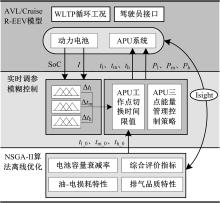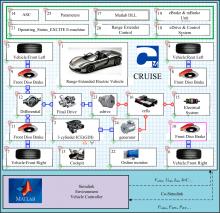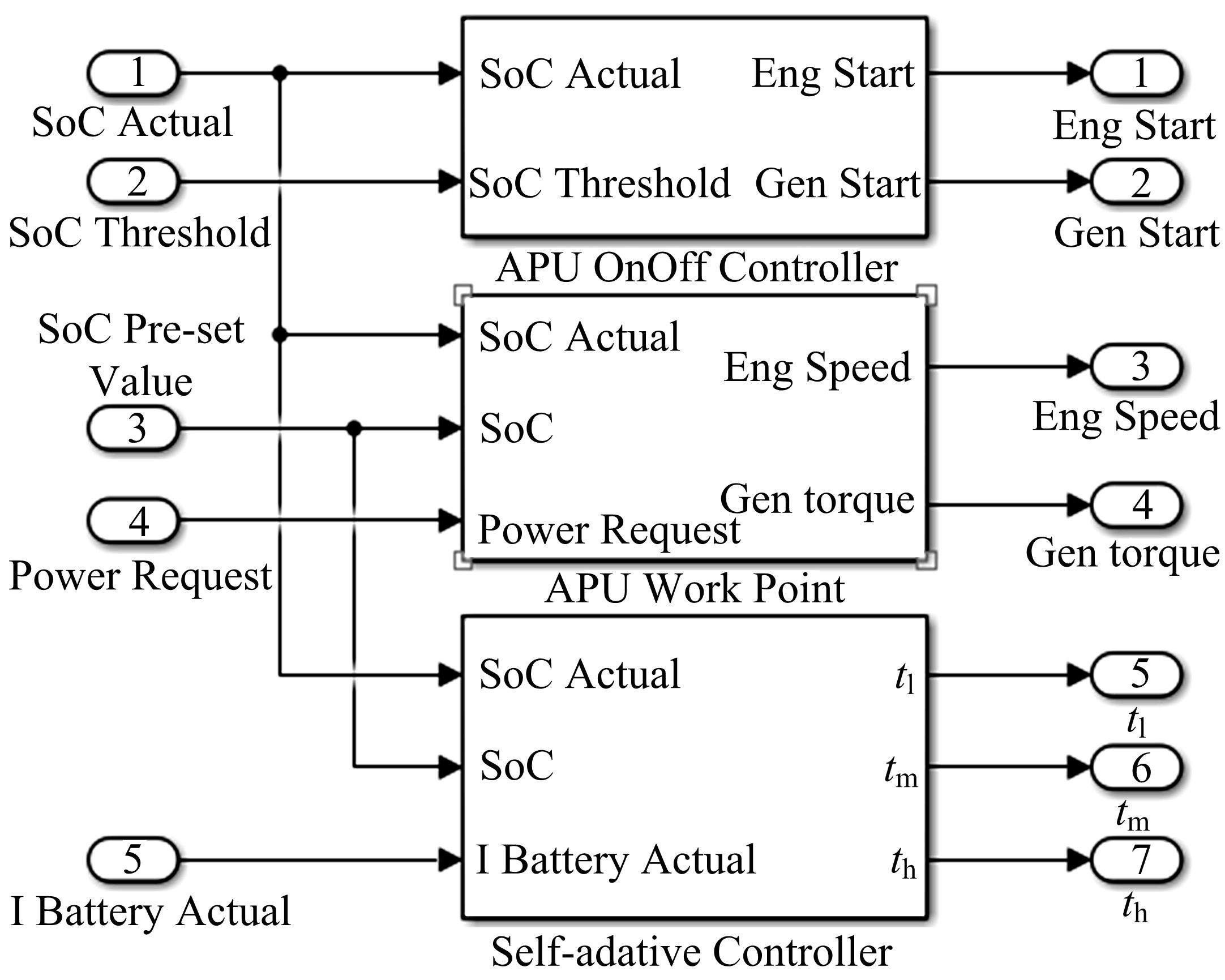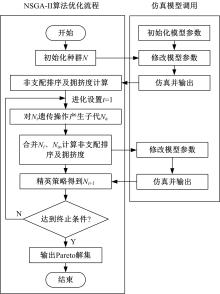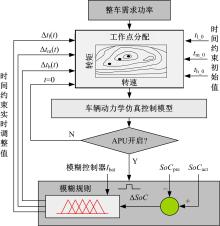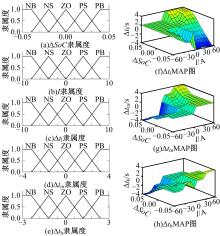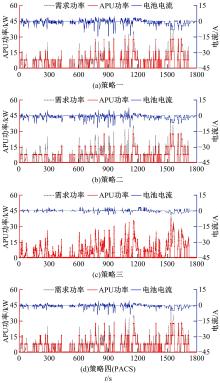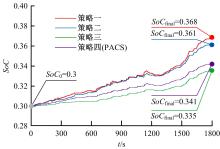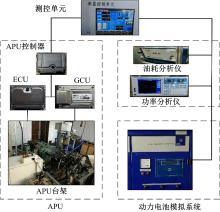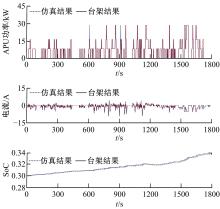吉林大学学报(工学版) ›› 2022, Vol. 52 ›› Issue (8): 1741-1750.doi: 10.13229/j.cnki.jdxbgxb20210168
• 车辆工程·机械工程 • 上一篇
增程式电动汽车增程器多点控制策略优化
- 1.吉林大学 汽车仿真与控制国家重点实验室,长春 130022
2.西华大学 交通与汽车工程学院,成都 610039
Multi⁃point control strategy optimization for auxiliary power unit of range⁃extended electric vehicle
Han-wu LIU1( ),Yu-long LEI1,Xiao-feng YIN2,Yao FU1(
),Yu-long LEI1,Xiao-feng YIN2,Yao FU1( ),Xing-zhong LI1
),Xing-zhong LI1
- 1.State Key Laboratory of Automotive Simulation and Control,Jilin University,Changchun 130022,China
2.School of Transportation and Automotive Engineering,Xihua University,Chengdu 610039,China
摘要:
针对增程式电动汽车增程器多点控制策略的优化问题,提出了一种基于多目标参数优化结果的增程器能量管理控制策略。首先,基于AVL-Cruise和Matlab-Simulink软件搭建整车系统仿真控制模型,基于NSGA-Ⅱ算法,以循环工况下的系统能耗、排放和电池容量衰减率为目标函数,以增程器最小持续工作时间为优化变量,构建了多目标优化模型。离线优化得到综合评估指标下的发动机最小持续工作时间Pareto最优解。设计了模糊控制器,在线实时调整发动机各工作点最小持续工作时间。结果表明:可实时调参的增程器多点控制策略能有效平衡能耗、排放和电池容量衰减率的关系,在有效降低能耗和排放的同时维持了较小的电池容量衰减率。
中图分类号:
- U461.8
| 1 | Bohnes F A, Gregg J S, Laurent A. Environmental impacts of future urban deployment of electric vehicles: assessment framework and case study of copenhagen for 2016~2030[J]. Environmental Science & Technology, 2017, 51(23): 13995-14005. |
| 2 | 申永鹏, 王耀南, 孟步敏, 等. 增程式电动汽车功率流优化策略[J]. 中国电机工程学报, 2015, 35(16):4035-4042. |
| Shen Yong-peng, Wang Yao-nan, Meng Bu-min, et al. Power flow optimization strategy for range-extended electric vehicles[J]. Proceedings of the Chinese Society of Electrical Engineering, 2015, 35(16): 4035-4042. | |
| 3 | 闵海涛, 叶冬金, 于远彬. 增程式电动汽车控制策略的优化[J]. 汽车工程, 2014, 36(8): 899-903, 943. |
| Min Hai-tao, Ye Dong-jin, Yu Yuan-bin. Optimization of the control strategy for range extended electric vehicle[J]. Automotive Engineering, 2014, 36(8): 899-903, 943. | |
| 4 | 宋传学, 王达, 宋世欣, 等. 基于动力分布设计的增程式电动汽车[J]. 吉林大学学报: 工学报, 2015, 45(3): 681-688. |
| Song Chuan-xue, Wang Da, Song Shi-xin, et al. Extended-range electric vehicle based on power distribution design[J]. Journal of Jilin University(Engineering and Technology Edition), 2015, 45(3): 681-688. | |
| 5 | Li J, Wang Y, Chen J, et al. Study on energy management strategy and dynamic modeling for auxiliary power units in range-extended electric vehicles[J]. Applied Energy, 2017, 194(15): 363-375. |
| 6 | Chen Z, Mi C C, Xiong R, et al. Energy management of a power-split plugin hybrid electric vehicle based on genetic algorithm and quadratic programming[J].Journal of Power Sources,2014,248(7): 416-426. |
| 7 | Molina D, Lu C, Sherman V, et al. Model predictive and genetic algorithm-based optimization of residential temperature control in the presence of time-varying electricity prices[J]. IEEE Transactions on Industry Applications, 2013, 49(3): 1137-1145. |
| 8 | Song Z, Hofmann H, Li J, et al. Optimization for a hybrid energy storage system in electric vehicles using dynamic programing approach[J]. Applied Energy, 2015, 139: 151-162. |
| 9 | Zhang S, Xiong R. Adaptive energy management of a plug-in hybrid electric vehicle based on driving pattern recognition and dynamic programming[J]. Applied Energy, 2015, 155(1): 68-78. |
| 10 | Xu L F, Yang F Y, Li J Q, et al. Real time optimal energy management strategy targeting at minimizing daily operation cost for a plug-in fuel cell city bus[J]. International Journal of Hydrogen Energy, 2012, 37: 80-92. |
| 11 | 林歆悠, 莫李平, 罗勇, 等. 基于能量预测的增程式电动汽车分时混动能量管理策略[J]. 汽车工程, 2017, 39(4): 369-375. |
| Lin Xin-you, Mo Li-ping, Luo Yong, et al. Time-sharing hybrid energy management strategy for extended-range electric vehicles based on energy prediction[J]. Automotive Engineering, 2017, 39(4): 369-375. | |
| 12 | Xie S, Hu X, Qi S, et al. Model predictive energy management for plug-in hybrid electric vehicles considering optimal battery depth of discharge[J]. Energy, 2019, 173(15): 667-678. |
| 13 | Xu L, Ouyang M, Li J, et al. Application of pontryagin's minimal principle to the energy management strategy of plugin fuel cell electric vehicles[J]. International Journal of Hydrogen Energy, 2013, 38(24): 10104-10115. |
| 14 | 席利贺, 张欣, 孙传扬, 等. 增程式电动汽车自适应能量管理策略[J]. 吉林大学学报: 工学版, 2018, 48(6): 13-21. |
| Xi Li-he, Zhang Xin, Sun Chuan-yang, et al. Adaptive energy management strategy for extended-range electric vehicles[J]. Journal of Jilin University(Engineering and Technology Edition), 2018, 48(6): 13-21. | |
| 15 | Berecibar M, Garmendia M, Gandiaga I, et al. State of health estimation algorithm of LiFePO4 battery packs based on differential voltage curves for battery management system application[J]. Energy, 2016, 103(15): 784-796. |
| 16 | Li J, Jin X, Xiong R. Multi-objective optimization study of energy management strategy and economic analysis for a range-extended electric bus[J]. Energy Policy, 2017, 194(15): 798-807. |
| 17 | Liu H W, Lei Y L, Fu Y, et al. An optimal slip ratio-based revised regenerative braking control strategy of range-extended electric vehicle[J]. Energies, 2020, 13(6): 1-21. |
| 18 | Kamjoo A, Maheri A, Dizqah A M, et al. Multi-objective design under uncertainties of hybrid renewable energy system using NSGA-II and chance constrained programming[J]. International Journal of Electrical Power & Energy Systems, 2016, 74(1): 187-194. |
| 19 | 王庆年, 于永涛, 曾小华, 等. 基于CRUISE软件的混合动力汽车正向仿真平台的开发[J]. 吉林大学学报: 工学报, 2009, 39(6): 1413-1419. |
| Wang Qing-nian, Yu Yong-tao, Zeng Xiao-hua, et al. Development of a forward simulation platform for hybrid electric vehicles based on CRUISE software[J]. Journal of Jilin University(Engineering and Technology Edition), 2009, 39(6): 1413-1419. | |
| 20 | Liu H, Lei Y, Fu Y, et al. Multi-objective optimization study of regenerative braking control strategy for range-extended electric vehicle[J]. Applied Sciences, 2020, 10(5): 10051789. |
| 21 | Goroohi S I, Ameli M T. A fuzzy-based non-dominated sorting genetic algorithm-II for joint energy and reserves market clearing[J]. Soft Computing, 2016, 20(3): 1161-1177. |
| 22 | Vassilyev S N, Kudinov Y I, Pashchenko F F, et al. Intelligent control systems and fuzzy controllers. Ii. Trained fuzzy controllers, fuzzy PID controllers[J]. Automation and Remote Control, 2020, 81(5):922-934. |
| 23 | 申永鹏, 王耀南, 孟步敏, 等. 基于多目标优化模型的电动汽车增程器油耗及排放优化[J]. 控制理论与应用, 2015, 32(5): 631-640. |
| Shen Yong-peng, Wang Yao-nan, Meng Bu-min, et al. Fuel consumption and emission optimization of electric vehicle range extender based on multi-objective optimization model[J]. Control Theory and Application, 2015, 32(5): 631-640. |
| [1] | 高青,王浩东,刘玉彬,金石,陈宇. 动力电池应急冷却喷射模式实验分析[J]. 吉林大学学报(工学版), 2022, 52(8): 1733-1740. |
| [2] | 聂光明,谢波,田彦涛. 基于Frenet框架的协同自适应巡航控制算法设计[J]. 吉林大学学报(工学版), 2022, 52(7): 1687-1695. |
| [3] | 杨红波,史文库,陈志勇,郭年程,赵燕燕. 基于某二级减速齿轮系统的齿面修形优化[J]. 吉林大学学报(工学版), 2022, 52(7): 1541-1551. |
| [4] | 陈昭明,邹劲松,王伟,石明全. 改进粒子群神经网络融合有限元分析的铸锻双控动态成型多目标优化[J]. 吉林大学学报(工学版), 2022, 52(7): 1524-1533. |
| [5] | 张家旭,郭崇,王晨,赵健,王欣志. 基于半实物仿真平台的自动泊车系统性能评价[J]. 吉林大学学报(工学版), 2022, 52(7): 1552-1560. |
| [6] | 郝帅,程川泰,王军年,张君媛,俞有. 运动型SUV驾驶室布置人机优化设计与测试评价[J]. 吉林大学学报(工学版), 2022, 52(7): 1477-1488. |
| [7] | 华琛,牛润新,余彪. 地面车辆机动性评估方法与应用[J]. 吉林大学学报(工学版), 2022, 52(6): 1229-1244. |
| [8] | 马永杰,陈敏. 基于卡尔曼滤波预测策略的动态多目标优化算法[J]. 吉林大学学报(工学版), 2022, 52(6): 1442-1458. |
| [9] | 李雄,兰凤崇,陈吉清,童芳. Hybird III假人模型与CHUBM人体生物力学模型的正碰损伤对比[J]. 吉林大学学报(工学版), 2022, 52(6): 1264-1272. |
| [10] | 刘兴涛,刘晓剑,武骥,何耀,刘新天. 基于曲线压缩和极限梯度提升算法的锂离子电池健康状态估计[J]. 吉林大学学报(工学版), 2022, 52(6): 1273-1280. |
| [11] | 张英朝,李昀航,郭子瑜,王国华,张喆,苏畅. 长头重型卡车气动减阻优化[J]. 吉林大学学报(工学版), 2022, 52(4): 745-753. |
| [12] | 史文库,张曙光,张友坤,陈志勇,江逸飞,林彬斌. 基于改进海鸥算法的磁流变减振器模型辨识[J]. 吉林大学学报(工学版), 2022, 52(4): 764-772. |
| [13] | 庄蔚敏,陈沈,吴迪. 碳纤维增强复合材料包裹强化形式对钢管横向冲击性能的影响[J]. 吉林大学学报(工学版), 2022, 52(4): 819-828. |
| [14] | 李杰,陈涛,郭文翠,赵旗. 汽车非平稳随机振动空间域虚拟激励法及应用[J]. 吉林大学学报(工学版), 2022, 52(4): 738-744. |
| [15] | 李伟,宋海生,陆浩宇,史文库,王强,王晓俊. 复合材料板簧迟滞特性线性辨识方法[J]. 吉林大学学报(工学版), 2022, 52(4): 829-836. |
|
||
